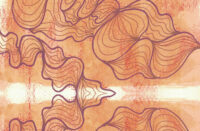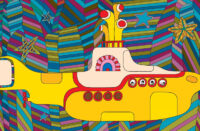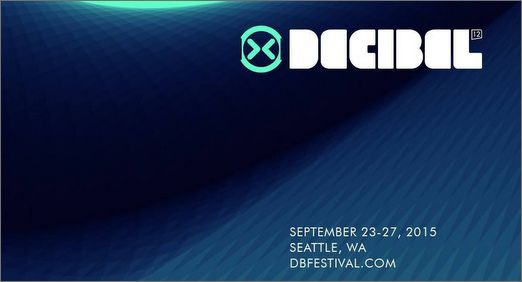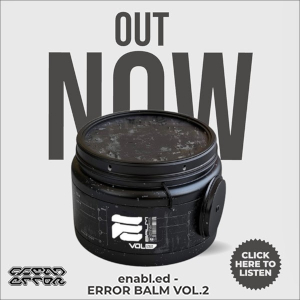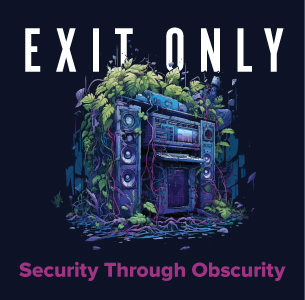
(10.14.05) I heard more than once during the Decibel Festival‘s Ambient Showcase on Sunday that sitting still is deadly. Especially after three full days of movement music. The Ambient Showcase takes place an the Broadway Performance Hall, the seated theatre where we had our noodles experimented on the previous day, and the Festival schedule is taking its toll on the audience. There are empty seats scattered throughout the auditorium and a number of heads nodding in a narcoleptic way during the sets. It’s a comedown event, a bit of sanctuary from beat bludgeoning and getting gouged in the kidneys by the spastic guy next to you who goes all epileptic during a stutter step of the house beat.
A tag-team affair between the Ghostly International and Kranky labels, the Ambient Showcase begins with drift, wanders through strange foreign lands, goes off the rails for a bit with some strong beats, and then crawls north into the bleak landscapes of the quiet city. Loscil opens the evening with a half hour of aquatic drift. With three deliciously diaphanous records under his belt for Kranky (Triple Point, Submers and First Narrows), Scott Morgan is continually refining his generative music. He feeds samples and field recordings into home-tweaked filters and DSP patches to produce elegiac sweeps of liquid sound. Out of focus greenery and clouds float on the video screen, a visual accompaniment to the drifting beats and wavery ambience.
There’s a hint of environmental ambience to the music as well, with chairs creaking, plastic rustling, people coughing and wheezing (well, me mainly; it’s that old bones thing again) in the audience. There’s a bit of John Cage‘s “4’33″” in the audience, an awareness of the sounds we’re making and how they impact the ambient nature of the performance. Loscil builds fragile tone melodies with the barest hint of percussion like a tiny pop of persistent static. Time-lapse photography of clouds morphs while ambient organ music swells, the tones rising beneath the clouds into a slowly swelling high pressure ridge, tiny atmospheric pops like rain snapping off a tarp. This is a hymn to sunrise, a ululating call from a chorus of frogs made angelic by dew.
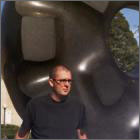
Lusine (who has recently landed at Ghostly with Serial Hodgepodge after a number of equally stellar records at Hymen Records, U-Cover and Delikatessen Records) discards all of the sweet IDM crunchery he has built up over the past few years for a completely ambient set, filled with the whisper of field recordings, the crackle of noise and the heartfelt drift of tonal melodies. He’s the only one who uses field recordings (mostly of people’s voices as illicitly captured in public places) extensively and, as an ambient instrument, they force another level of perception upon the audience. That question again: when it is just sound and when it is music?
Bell tones and static fields rise through a subway station in Japan while a heavy thrum (“bitter of beat” I appear to have scribbled in my notebook) undercuts the voices in his second track. It’s a combination of the static weather of Fennesz and the artic hum of Biosphere with a layer of whispers. Using voices speaking foreign languages as textual backdrops, Lusine‘s ambience is one of active listening. You feel like an eavesdropper, like a criminal hiding in the trash bin at a train station, listening intently to the nearby conversations while the ground beneath you rattles with the approach of trains and the tiny melodies of forgotten radio signals drift past.
It’s all about the layering, really, and Lusine knows how to layer. Even his visuals are swirling patterns and images that bleed into one another. Slow motion footage of dancing Asian children is overlaid by shots of city streets and car lights while crackling ambience gives way to breathy tones rich with a foundation of fog horns and static pops. Slow dissolve to steam ambience and ducks. With guitar. And it is fucking awesome.
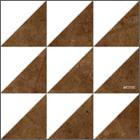
It’s a tough act to follow, and Aeroc takes a hard right with the ambience when it’s his turn. The working name of Geoff White, Aeroc delivers guitar ambience with slithering rhythms, but tonight he comes on strong with the beats. His guitar work (at least, the recordings of it as he’s just got his laptop with him) is blissful and elegant, carefully modulated melodies that soar like birds with gossamer plumage. But he buries it beneath the hard pop of percussion and electronic beats. It puts me off and, going back to his Viscous Solid record from last year I can see that it isn’t entirely unexpected, but still, it knocks me abruptly out of the deliciously receptive state I’ve been molded into Lusine‘s set. I wander around the lobby of the auditorium, listening to muttered conversations of other concert-goers as they lament the physical shortcomings of their own bodies (we all get old; age strikes some of us hard after 72 hours plus of strenuous musical enjoyment).
Listening to Viscous Solid as I write up this column on the weekend, I see how the mix didn’t help White that night. Viscous Solid is a delightful record, a warm and comforting combination of guitar and scattered beat like wind and sand playing together with your toes. But that night, in that room, too much sand — rocks actually, big massive boulders of sound — not enough wind.
Mark Nelson, who emerged onto the music scene as the vocalist and guitar player for Labradford, has been experimenting with sampling and dub echoes for four records now as Pan*American (including last year’s Quiet City where he married his music to video footage in a very low-key and moving way) and, for Decibel, he brought along a friend to play live drums. One of the few real drum kits I spotted all weekend, Pan*American‘s rhythm section was done with rubber-headed mallets and soft wire brushes. Nelson loops his guitar work (all very lush and diaphanous) through his sampler to build cathedrals of sound, and, thus built, he would tweak and decay the looped sound into stormy nothingness. His drones become haunted melodies that drift like spectral phantoms beneath a miasma of static, moving from an aquatic piece into a more rarified atmosphere of thin air and cold wind gusting across desolate highlands.
Nelson‘s work has always seemed like meditations on landscapes — both rural and urban — though most feel like they’re bereft of human life. Not ruins, not the aftermath of human civilization, but rather scenes that unfold in solitude. As his visuals fade into a black and white film of a deserted warehouse near the harbor, his ambience takes on a more urban texture — filled with grit and pop like the dust and smog of the city. His guitar begins to squeak and give voice to warped notes, the sound unable to resonate fully because of the man-made walls that hem it in. Nelson makes Urban Frippertronics — waves of guitar ambience that overlay themselves into a thickening sprawl of sound.
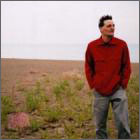
Like a number of the ambient and the experimental artists, Nelson is a firm believer in the use of static as an instrument. It’s an interesting phenomena in this age of digital clarity. Even as one of the panels over the weekend discusses the future of digital distribution — the immediate transfer of pristine digital copies of sound files — the artists are injecting chaos and damage into their music with conscious intent. The dusty sounds of old phonograph needles and poorly shielded amplifiers are no longer signs of shoddy workmanship or cheap investments in stereo equipment but are meant as part of the “ambience” of the piece. Is it something living, some chaotic element introduced into a work in an effort to make something fresh and living, or is it an effort to bend raw noise to the artist’s will?
I wander down the street after the Ambient Showcase to Neumos and the Bad Juju Lounge to take in the final two-fer of the weekend: the Hedfunk sessions and the showcase of local Basskamp artists. Ghostly’s Cepia is on the main stage, playing to a crowd of about twenty-five. I’m not sure what else Seattle has to do at 9:30 PM on a Sunday night, but they’re evidently not here and it’s their loss as Cepia delivers a set that is deep on smart beats and, in the shallow drifts, you can hear guttering machine noise and the snap-pop of ungainly ambience. After a long weekend of hearing all sorts of beats and rhythms, you gain a ready understanding of what will keep your interest and what won’t. Cepia‘s constructs are filled with beats that defy organized rhythm, pulsating fields of textures that are flush and ripe with sound. There’s a little something here for everyone to find a latch, a hook, something to hang their interest on and follow to its end. It’s IDM that gets personalized as it enters your ear canal.
In the other room, local guitar and drum wizards Obelus are drawing a crowd. Guitarist Jason Goessl and drummer Adam Pessl are men with a thousand triggers. Obliterating the preconceptions of every audience member with their crackling set of wild melody, dervish drums and triggered effects, Obelus are demonstrating why they’ve been hosting the weekly Basskamp show every Sunday at the Lower Level in the Capitol Hill Arts Center. Pessl starts a couple of loops, Goessl finds a few drones to layer, and then they start to twist the rhythm and fuse the melodies to the clatter and chatter of triggered effects. It’s a mesmerizing set of traditional instruments making modern big beat music. There’s something unmistakably organic about live drums that no sythnesized beat-banger can match. It’s the completely human ability to lay on the back side of the beat which keeps the swing alive. Try as technology might to masquerade as a living player, it always hits the beat dead center. The drum machines haven’t got any jive, and can’t intuit much about swing. Which is why a crowd is packing in tight to hear Obelus: this funk is real.
Tipper is stroking digital-wax in the other room. He’s got a complete dance party stored in his G4 Macintosh and the turntable action on top of the fat electro is a bonus. Under his ministrations, the vinyl is a slithering, chattering minx. He strokes and fingers the wax with an intimate friendliness, coaxing bubbling moans and aborted cries of delight from it as the big beat house party gets all firehose-sweaty on the floor. It’s not as organic as Goesslv and Pessl chopping out a block of serious fusion in the next room, but it gets the floor moving.
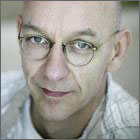
After the delirious swagger and bluster of Tipper, Thomas Felhmann comes on like he’s going to do a bit of soft shoe for the audience. Fehlmann, who has been working in electronic music for more than twenty years (not to mention more than a little time spent with The Orb), brings a loose-jointed affability to the room with his music. Bird song whistles through the minimal landscape of his techno like it’s a symphonic pastoral done in 4/4 big beat. The audience skips a beat here, the energy wound tight by Tipper is twisted into a knot as the full dance floor tries to shift gears with the change of artist. I see that Felhmann and the equally shaved head working the t-shirt table are the only ones getting it — wriggling their hips like they alone understand the underlying imperative for a deep grind to the rhythm. But Felhmann‘s just taking his time. While he gets down to his music — pumping away to the beat like a Disco Gigolo, almost to the point where he can’t stop to tweak a knob — the audience is caught between wanting to see if he’s going to hurt himself and dancing themselves. Eventually, they succumb. Whether it be to the energy of his movement or the humping pump of his beats, it’s hard to say. And it does really matter? The party goes on.
Is there a take-home summation from Decibel? The party goes on. Or Music is what you make of sound. It’s probably impossible to reduce four days — more than 70 musicians playing more than 50 hours of music — to a one-liner. Nor is such an ugly reductio ad absurdum argument what Decibel was striving to do. It’s a festival after all: a wild smorgasbord of genres and styles all crushed together so that there can be flow between genres, so that strange accidents and odd pollinations can occur. And, if the music speaks of anything, it says that there is a good deal of flow going on. It’s getting harder and harder to not get swept away in the great river of electronic music regardless of where you dip your toe into the flow. In that sense, the organizers of Decibel 2005 did a fantastic job of directing the flow in ways that allowed a good deal of random access. It was so easy to flit from eddy to eddy, to be carried by one current across the path of another, to fall into a pool and float into another; so easy, in fact, that one could accidentally drown in the music.







